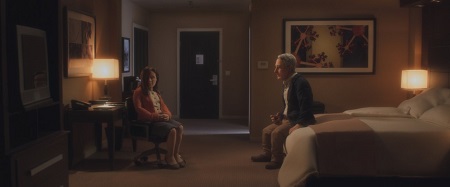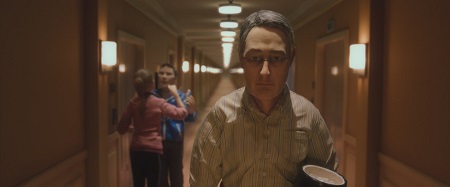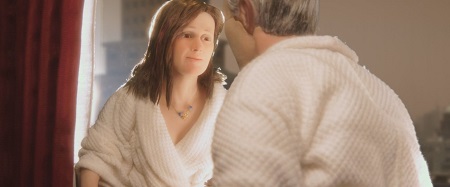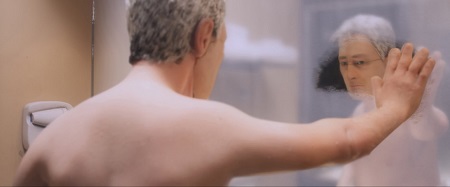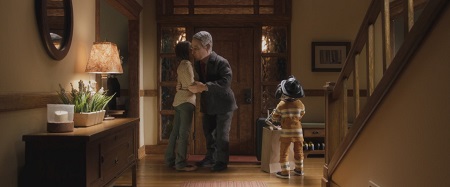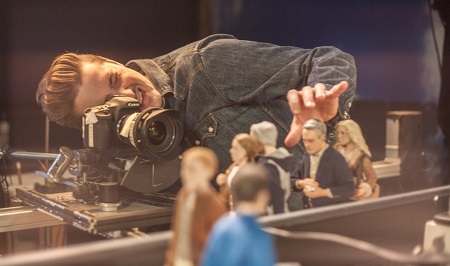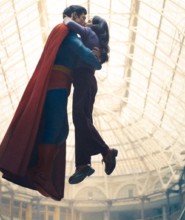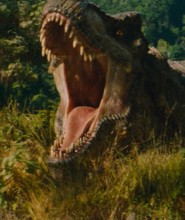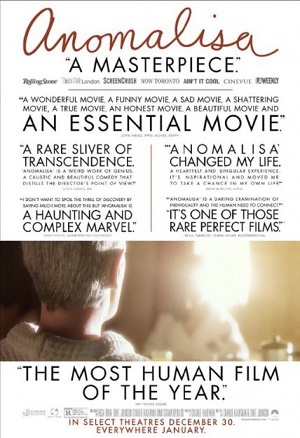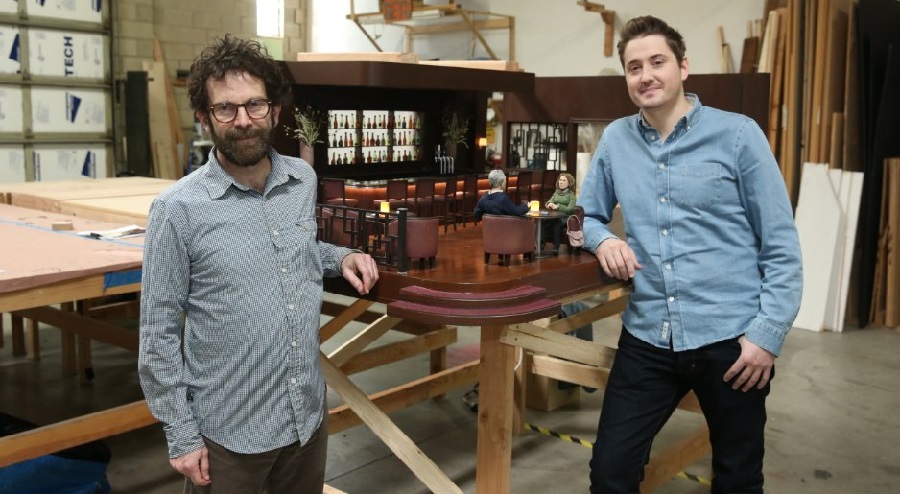
“Anomalisa” – Interview with Charlie Kaufman and Duke Johnson
by Sara Michelle Fetters - January 22nd, 2016 - Interviews
No Limits
Charlie Kaufman and Duke Johnson Battle Convention with Stop-Motion Anomalisa
Anomalisa was never intended to be a movie. Writer Charlie Kaufman meant the story to be a one-time thing, a stage audio play performed before a live audience with composer Carter Burwell providing the music and actors David Thewlis, Jennifer Jason Leigh and Tom Noonan delivering the performances. He imagined that was all there was to it, never thinking in a million years it would ever be performed again, let alone be the basis for a motion picture presentation. Enter Duke Johnson.
“I was working at an animation studio,” says Johnson. “Working in stop-motion with [producer] Dino Stamatopoulos, who is the creator of a number of stop-motion shows, and we had talked a lot about doing some stop-motion, but stop-motion for adults, finding more adult stories that could be told using this form of animation. We wanted to tell specific stories, and he mentioned he had this script for Anomalisa.”
“Now, there was nothing about this script that initially lent itself obviously to stop-motion, and that’s what I liked about it. It had compelling characters that seemed to have real authentic emotional experiences that we could connect with. That excited me.”
The resulting motion picture has been released to theatres earning acclaim from critics as well as an Academy Award nomination for Best Animated Feature. The day after the Oscar nominations, I sat down with Kaufman and Johnson, the former still seemingly a little surprised the film exists, let alone has met with almost universal praise, especially considering he wasn’t certain Anomalisa should have been transformed into a feature in the first place.
“I was reticent because it was meant not be seen,” Kaufman admits candidly. “But, at the same time, I knew Dino, I’d worked with him as a writer before and I really like and respect him, and I was additionally desperate to get stuff made, so, why not? Let’s try to do this. I told them, if they could raise the money then we would do it, and subsequently, I never expected to hear from them again. But they raised the money. And here we are.”
It took a Kickstarter campaign to raise that money, but once it was done the Oscar-winning screenwriter behind Being John Malkovich and Eternal Sunshine of the Spotless Mind had no problem jumping into the production with both feet, the fact it was going to be animated not worrying him a bit. “I like stop-motion,” he happily states. “It never scared me the movie was going to be in stop-motion. What made me reticent was, like I said, was that it was going to be visualized, and that was never supposed to be the case when I wrote the play.”
“First thing I had to do was throw away that idea, the idea that [Anomalisa] would never be seen. The second thing I had to do was to talk to Duke, to brainstorm concepts as to what we wanted the film to be. We also got the same actors back and we recorded them together, as if it were the play, which is also somewhat unusual for animation. But by working with them in this way, we were able to get this performance that we loved, and that in turn helped inform what the tone and the visuals would be for the finished film. But, most of all, Duke and I just talked, and that’s what we did throughout the entire production.”
For Johnson, these moments of conversational collaboration were key, allowing him to see the evolving feature in ways he could never have otherwise. “Our conversations about tone and the characters and the visualizations of certain things, those were everything,” he declares. “I’m a big fan of Charlie’s, but I was also able to bring my skills as a filmmaker and animator to the table, so our collaboration in that sense was something special. For me, though, it was a great experience to sit down with Charlie, to work with him, because I came into the production with so much respect and admiration for him, looked at him as something of a hero, which is also kind of intimidating.”
“But it’s also exciting, and I discovered so many things about myself as a filmmaker I don’t think I would have had we not collaborated. It was great.”
One of the more spectacular elements of Anomalisa is its production design, not typically an aspect of an animated feature most single out for praise. But the glory of the film is that it looks like every hotel a person has ever had the fortune – good, bad, in-between – to stay in at some point in their lives, yet somehow manages to utilize that mundane banality in a way that is fascinating and immersive. It gives the characters a believable playground to live within, and thus adds an extra layer of authenticity that never could have existed otherwise.
“We looked at a lot of hotel rooms,” laughs Kaufman with a crooked smirk. “It’s like anything. You do your research. We looked a lot of hotel rooms online. Duke and I stayed in some rooms overnight and took a bunch of pictures of every little thing. We talked to production designers trying to pick things out. Those are the idiosyncrasies you’re looking for. You have to know where the smoke alarms are. Where the hairdryer is. These things might seem minor but, in reality, they are anything but. If the hotel isn’t believable as an environment, then how can we expect audiences to accept the characters as real?”
“I think you hit the nail on the head,” adds Johnson. “We wanted the hotel to be specific. The color of the walls. Where the lights were. The pictures on the walls. And none of those things, like the pictures, existed in any actual hotel in the real world, but you have a sense as you watch the movie that they do, that you’ve stayed in a similar hotel room at some point in your life.”
All of which adds an extra layer of surrealism for the duo as they’ve spent the past few months going around the world talking about Anomalisa, staying in hotel rooms that remind them of the very ones they helped design for the film. “It’s very meta,” says Johnson with a goofy shrug. “It can get a little strange at times.”
“We have all of the experiences,” says Kaufman. “We have the experience with the shower. We have the experience with the malfunctioning key card. We have the room service experience. It’s been kind of, well, creepy. Definitely odd.”
“I had a new one today,” claims Johnson. “The bathroom lighting in every hotel room is different. I fix my hair. Fluff out my eyebrows. But sometimes the light is this extreme spotlight that casts these weird black shadows, so I have to get real close to the mirror, or I have to dim the lights or raise the lights depending on what I’m trying to groom. I look totally different in every bathroom. You watch the movie and you realize our main character Michael Stone has that same exact experience, and after staying in so many hotel rooms I can only imagine how often he’s had it.”
All of this plays into a greater discussion regarding the film’s humor. While Anomalisa is a comedy, it’s comedy born from some tragically heartfelt and intimate places. The film features an emotionally crippled hero who for no concrete reason appears to be estranged from his wife and child, and while on a business trip ends up pondering having an affair with a woman attending the conference he’s scheduled to speak at. It’s bleak, yet also very funny, striking the proper balance between comedy and drama the fine line the directors tasked themselves to walk.
“When I’m writing stuff I’m always trying to figure out what the balance is between the scripted gag and what is organically funny in the moment,” says Kaufman. “There are always things where we feel like, we know this is funny, we know this is going to get a laugh, this is intended to be humorous, scenes like Michael in the shower or the guy masturbating at the window. Those moments are intended to be funny.”
“But there still should be something creepy about them. Something real. Something that makes you feel like they would exist within this world we have created. And they’re born out of real things. Not to keep going back to the guy masturbating at the window but, thinking about it now, it’s funny, but there’s also something really sad about it to me, too. The guy is sitting in an empty office all alone [getting excited] in front of a computer. Why is he doing that? Who is he? It’s sad.”
Which brings things back again to the protagonist Michael Stone. He’s not an inherently likeable character, and it’s easy to imagine some viewers will be turned off by him and his actions. Not that this was a thing that concerned Kaufman. “I don’t spend a lot of time worrying about that,” he admits. “I choose not to think about that. The first movie that I wrote the main character locks his wife in a cage with an ape, which isn’t a very likeable thing to do. But it is understandable, at least, I hope it is, and that’s all I care about. You get why he did it even though it was a horrible thing to do. If you make characters likeable than you’re only obsessed with success with an audience and not with doing something honest; I try to avoid that.”
“Although, I do like success with an audience. Who doesn’t? But if I’m going to get success with an audience I want it to come from something that feels true to me.”
It’s one thing to collaborate with Charlie Kaufman. It’s another to realize you’re going to be going into this production with, not only the creative force behind the play, but also the three talented actors who originally brought it to life. “It was kind of a package deal,” says Johnson with a grin. “These are like, phenomenal actors. I love all of them. I love them for many of the same reasons that Charlie does. We had some different favorite references as far as Tom Noonan was concerned, but we both surprisingly had similar ones for both Jennifer Jason Leigh and particularly David Thewlis. We’re both big fans of Naked and David’s performance in that film, and the character of Michael Stone just feels so perfect for him.”
“But, yeah, I was like, David Thewlis? Jennifer Jason Leigh? Tom Noonan? Are you kidding? Sure. They work. I’m okay with that. I was super-excited.”
“I honestly don’t know what I would have said about making the film had any of them said no to us,” adds Kaufman. “I might have said no had they not all be available. I knew that they would want to do it, but schedules are tricky, and had it been a scheduling thing leading to their being unavailable, I had no idea how I would go about casting their replacements. These characters were created with them in mind. I had such a good time doing the play with them. And then to replace them? To have someone replace David or Jennifer or Tom? I think I would have rather not have done the movie.”
As wonderful as Thewlis and Leigh are, the true breakout star ends up being Noonan, the veteran character actor tasked with playing every single supporting character in the story other than the two being portrayed by his two costars. “We could talk for hours about the genius of Tom Noonan,” says Kaufman with matter-of-fact certitude. “He does it all here in real-time, keep that in mind. For example, during the scene at the end, he’s playing the mother and the son, as well as all of the extras, one right after the other. There was no pausing so Tom could collect his thoughts. It’s amazing. And he obviously did that when we performed the play, as well. He’s just great.”
“It was good,” adds Johnson half-jokingly. “No. Seriously. The man is amazing. Like you just said. Tom’s a genius.”
“The voice records were the easiest and most immediately satisfying part of the process, and I’m so glad we did that first. It set the tone for everything else. The moment that always pops into my head is Jennifer singing Girls Just Want to Have Fun, because it was originally a different song in the play, it was My Heart Will Go On, and we couldn’t get the rights. So Jennifer came there prepared to do other songs, and then she sang that one and afterwards, it was very quiet. She was like, how’s that? And we were all thinking to ourselves, maybe this is going to be an amazing movie? Maybe we’ve got something here? And it was because of moments like that when were recording the audio. The kind of magic David, Jennifer and Tom were creating? It blew us all away.”
Running out of time, there was one technical aspect of the film I wanted to quickly touch upon, and that was director of photography Joe Passarelli’s expressive and immersive camerawork. “It’s one of the biggest challenges,” admits Johnson. “We set out to make this movie cinematic. We didn’t want to be confined by the perceived limitations of animation. If a character is was going to walk down a hall, if a character was going to walk into an elevator, if this was going to be a Steadicam shot in a live-action film, how do you do that in animation? There was no immediate answer. Joe and the rest of us, we had to figure those things out. You have to make it happen. It’s intricate and beautiful. The stuff they had to do in this was amazing.”
As for general audiences, both filmmakers are eager to see how the film performs for them. “We sort of make it a point that we don’t want to dictate what people are going to think about the movie,” says Kaufman. “We made it, and what we hope for is that they are engaged with it and that it interests them, but their interpretations of all that transpires should be theirs and theirs alone. We hope that it reflects aspects of their lives, that they can relate to it, but we’ve also learned from hearing from those that see it that they all get different things from the experience, that they all feel different emotions. We want to keep that field open.”
“I do want them to be open to experiencing something new,” appends Johnson. “They think of animation, they think of Pixar and Disney. When the think of Kaufman and drama, they think of live-action. I want them thinking, what is this? I want them to realize that this is something different. I want them to be open to the experience of Anomalisa, that they connect with it, that they don’t limit themselves to the conventions of what animation or drama are supposed to be. That would be great.”
– Portions of this interview reprinted courtesy of the SGN in Seattle
